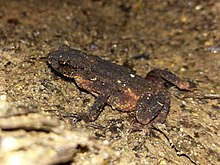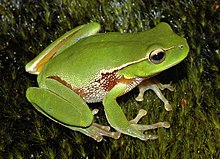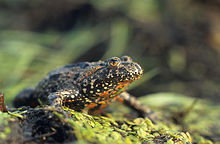Portal:Amphibians
The Amphibian Portal
Amphibians are ectothermic, anamniotic, four-limbed vertebrate animals that constitute the class Amphibia. In its broadest sense, it is a paraphyletic group encompassing all tetrapods, excluding the amniotes (tetrapods with an amniotic membrane, such as modern reptiles, birds, and mammals). All extant (living) amphibians belong to the monophyletic subclass Lissamphibia, with three living orders: Anura (frogs), Urodela (salamanders), and Gymnophiona (caecilians). Evolved to be mostly semiaquatic, amphibians have adapted to inhabit a wide variety of habitats, with most species living in freshwater, wetland or terrestrial ecosystems (such as riparian woodland, fossorial and even arboreal habitats). Their life cycle typically starts out as aquatic larvae with gills known as tadpoles, but some species have developed behavioural adaptations to bypass this.
The young generally undergo metamorphosis from larva with gills to an adult air-breathing form with lungs. Amphibians use their skin as a secondary respiratory surface and some small terrestrial salamanders and frogs lack lungs and rely entirely on their skin. They are superficially similar to reptiles like lizards, but unlike reptiles and other amniotes, require water bodies in which to breed. With their complex reproductive needs and permeable skins, amphibians are often ecological indicators; in recent decades there has been a dramatic decline in amphibian populations for many species around the globe.
The earliest amphibians evolved in the Devonian period from sarcopterygian fish with lungs and bony-limbed fins, features that were helpful in adapting to dry land. They diversified and became ecologically dominant during the Carboniferous and Permian periods, but were later displaced in terrestrial environments by early reptiles and basal synapsids (mammal predecessors). The origin of modern amphibians belonging to Lissamphibia, which first appeared during the Early Triassic, around 250 million years ago, has long been contentious. However the emerging consensus is that they likely originated from temnospondyls, the most diverse group of prehistoric amphibians, during the Permian period. (Full article...)
Selected frog article

The tailed frogs are two species of frogs in the genus Ascaphus, the only taxon in the family Ascaphidae /æˈskæfɪdiː/. The "tail" in the name is actually an extension of the male cloaca. The tail is one of two distinctive anatomical features adapting the species to life in fast-flowing streams. These are the only North American frog species that reproduce by internal fertilization. They are among the most primitive known families of frogs.
Its scientific name means 'without a spade', from the privative prefix a- and the Ancient Greek skaphís (σκαφίς, 'spade, shovel'), referring to the metatarsal spade, which these frogs do not have. (Full article...)Selected salamander article
The Caudata are a group of amphibians containing the extant salamanders (the order Urodela) and all extinct species of amphibians more closely related to salamanders than to frogs. They are typically characterized by a superficially lizard-like appearance, with slender bodies, blunt snouts, short limbs projecting at right angles to the body, and the presence of a tail in both larvae and adults.
Disagreement exists between different authorities as to the definition of the terms "Caudata" and "Urodela". Some maintain that Urodela should be restricted to the crown group, with Caudata being used for the total group. Others restrict the name Caudata to the crown group and use Urodela for the total group. The former approach seems to be most widely adopted and is used in this article. (Full article...)List of selected salamander articles
|
|---|
Did you know? –

- ... that the Mexican burrowing caecilian (pictured) is viviparous, with the young feeding on glandular secretions in the oviduct?
- ... that the red-cheeked salamander, which is distasteful to predators, is mimicked by the harmless imitator salamander?
- ... that the Black Salamander may defend itself by biting a western garter snake attacking it?
- ... that the Ouachita Dusky Salamander, the Fourche Mountain Salamander (pictured), and the Rich Mountain Salamander are all endemic to the Ouachita Mountains in Arkansas and Oklahoma?
- ...that the American toad is a common species of toad found throughout the eastern United States and Canada?
Selected amphibian type
Toad is a common name for certain frogs, especially of the family Bufonidae, that are characterized by dry, leathery skin, short legs, and large bumps covering the parotoid glands.
A distinction between frogs and toads is not made in scientific taxonomy, but is common in popular culture (folk taxonomy), in which toads are associated with drier, rougher skin and more terrestrial habitats. (Full article...)List of selected amphibian type articles
|
|---|
Selected images
Selected toad article

Ansonia inthanon is a species of toad in the family Bufonidae.
A small stream toad, measuring only 22-26mm in length. Its natural habitat is near torrents in subtropical forest on sloping land. It is threatened by habitat loss for agriculture, use by medical research (although this is not a significant threat) and by the introduced American bullfrog. Though it is only known from Doi Inthanon National Park and Thongphaphum in Kanchanaburi Province, it is not rare in suitable habitat. The species was recently discovered in a third locality, Doi Suthep National Park in Chiang Mai Province, and may also exist in similar habitat in northern Thailand and adjacent Myanmar. (Full article...)Selected caecilian article

The Western Ghats in India are home to several species of caecilians (Gymnophiona).
Caecilians are legless, burrowing amphibians which mostly live in leaf litter, loose soil, under rocks and decaying logs. They are also found in agricultural fields and only surface during the monsoon. The body is elongated and smooth with a slimy skin. The smaller caecilians superficially resemble earthworms while the larger ones are often mistaken for snakes. However, they can be told apart from earthworms by the presence of eyes, teeth and skeleton and from snakes by the lack of scales on skin. The eyes in caecilians are not well developed which is most likely to be because of their burrowing life style. They are considered as rare which is apparently due to their subterranean habits. To see them one has to search carefully (usually by digging) and be at the right place and at the right time. There are few places where they are common, but, at least one species was reported to be abundant in agricultural fields in Kerala. The larger caecilians can resemble snakes, but their skin is smooth, not scaly. (Full article...)Need help?
Do you have a question about Amphibians that you can't find the answer to?
Consider asking it at the Wikipedia reference desk.
Topics
Subcategories
Related portals
Associated Wikimedia
The following Wikimedia Foundation sister projects provide more on this subject:
-
Commons
Free media repository -
Wikibooks
Free textbooks and manuals -
Wikidata
Free knowledge base -
Wikinews
Free-content news -
Wikiquote
Collection of quotations -
Wikisource
Free-content library -
Wikiversity
Free learning tools -
Wiktionary
Dictionary and thesaurus









































